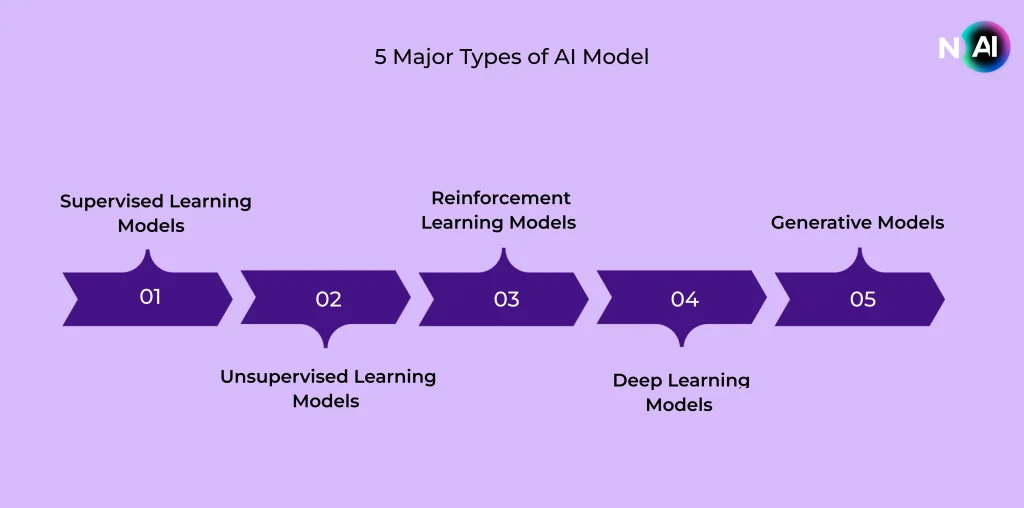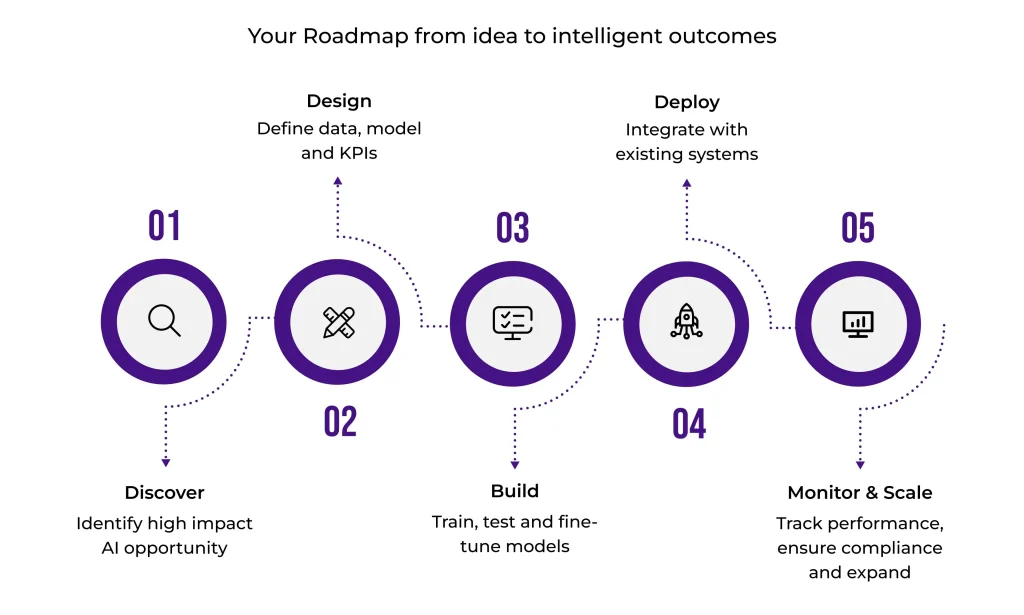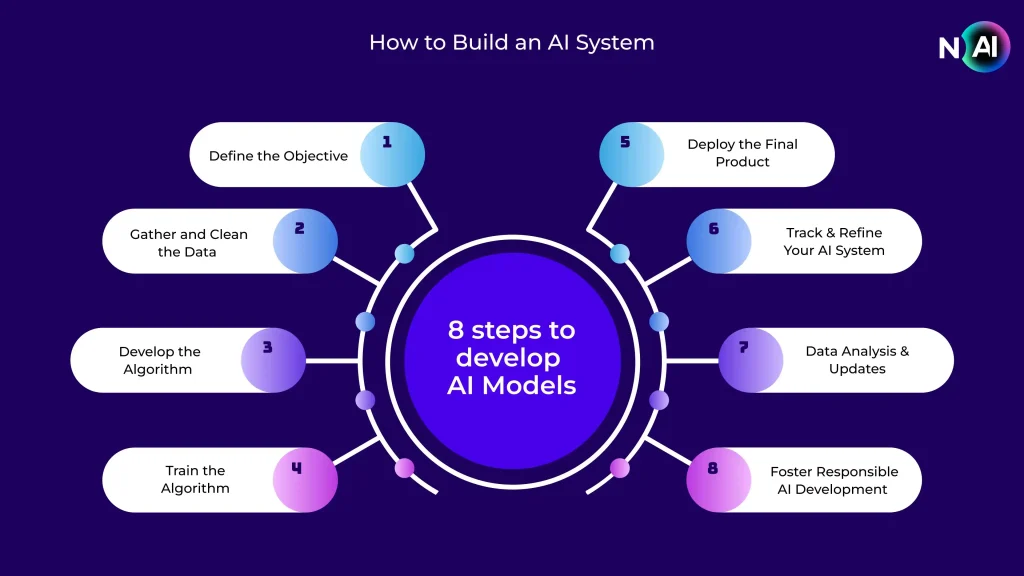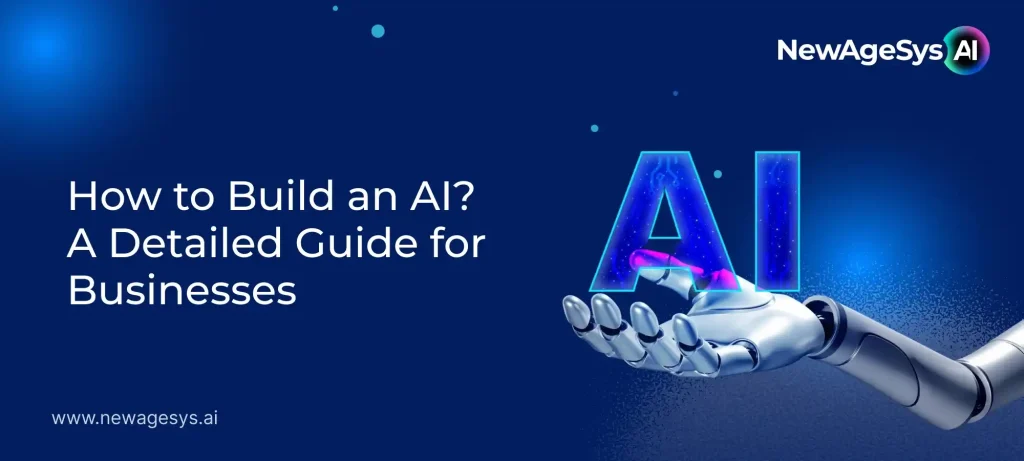| TL;DR Over 92% of businesses are already using AI, and early adopters are expected to see a 38% boost in profitability by 2035, according to McKinsey. AI surpasses conventional programming by learning from data patterns rather than following fixed rules, making it ideal for solving complex and unpredictable problems. Different AI models serve distinct purposes; this could vary from supervised learning for classification to generative models that create new data, such as images or text. Python dominates AI development, supported by powerful libraries such as TensorFlow, PyTorch, and Scikit-learn, which simplify the building and training of models. Building an AI system follows a clear process—define objectives, gather and clean data, develop and train algorithms, deploy the model, and continuously monitor performance. AI development costs range widely, from $20,000 to $50,000 for simple models to over $2.5 million for complex systems, such as NLP or predictive analytics. |
Imagine this scenario: A well-known retail brand struggled to predict the demand for its quickly selling products. This led to a situation where their stock was either empty or overflowing. And the result? Loss of customers and wastage of goods. Fortunately, they have now harnessed the power of AI and integrated an AI-driven demand forecasting system. To their surprise, the inventory levels rose in line with customer behavioral patterns, sales spiked, and wastage was nearly zero.
Does it sound like a fictional story? Not anymore; AI has already been augmenting businesses and industries worldwide. Approximately 92% of businesses are already leveraging AI, and those that adopt it at an early stage are expected to increase their profitability by 38% by 2035, according to McKinsey insights. From healthcare firms that detect diseases to self-driving cars and customer behavior prediction, and logistics firms that reduce delivery costs through efficient routing, AI is taking new forms and driving business processes more effectively.
Now, how to build an AI that is well-customized to your customers, business, and end goals? This blog is a guide, with a detailed look into how your business can build AI solutions and leverage them as a growth engine for a successful future.
AI Vs Conventional Programming Explained
Conventional programming employs a rule-based approach. This involves writing logic, defining inputs and outputs, and bringing consistent results. AI systems don’t adopt fixed rules; instead, they learn from the patterns generated through training data.
The performance of these systems depends on the way they are trained. This creates flexibility, but it also makes debugging more difficult. In several applications, conventional software and AI complement each other. While logic manages the predictable, AI takes care of the fuzzy.
Breaking Down AI & Concepts
Before learning how to build an AI, it is essential to understand what AI is. AI refers to the machine or software that can execute tasks that specifically demand human intelligence. These tasks can be reasoning, learning, problem-solving, and natural language understanding. AI can be classified into different types, like:
- Machine Learning (ML): Algorithms that let computers learn from data.
- Natural Language Processing (NLP): Helps machines understand and respond to human language.
- Computer Vision: Lets computers interpret and process visual information.
- Robotics: AI integration with physical machines.

Why Do You Need AI Models for Business?
By helping machines process input data and learning patterns, AI helps you make decisions with the least human involvement. AI models drive businesses to streamline processes, personalize customer interactions, and extract insights more efficiently compared to traditional techniques.
Whether it’s fraud detection, demand forecasting, or image recognition, AI models drive efficiency and innovation. Knowing how to build an AI model enables organizations and individuals to develop the tools necessary to break down complex problems and remain competitive in an evolving market. To leverage these advantages, it is essential to identify the types of AI models and their respective differences in application.
AI Models: Types & How They Differ From Each Other

It is essential to understand the various types of AI models when considering how to create an AI model that meets your specific needs. Every model has its own benefits and areas of application, ranging from image processing to language processing, predictions, and more.
- Supervised Learning Models
By learning from labeled data, these methods are ideal for tasks such as regression and classification. Common algorithms include decision trees, linear regression, support vector machines, and others. These require a specific mapping between input and output, making them ideal for known problem areas.
- Unsupervised Learning Models
These models operate by analyzing unlabeled data to identify patterns or groupings that are otherwise hidden. This category encompasses clustering and dimensionality reduction techniques, including Principal Component Analysis (PCA). They are highly used to explore data, detect anomalies, and segment customers.
- Reinforcement Learning Models
Reinforcement models interact with an environment and earn feedback via penalties or rewards. They are used in gaming, robotics, and autonomous mechanisms. They allow you to build models that can improve through trial and error over time.
- Deep Learning Models
As a subset of machine learning, it utilizes artificial neural networks to manage complex and large datasets. Deep learning models are adept at tasks such as NLP, image recognition, and speech recognition. Examples include RNNs (Recurrent Neural Networks) and CNNs (Convolutional Neural Networks).
- Generative Models
Models that include Generative Adversarial Networks (GANs) and Variational Autoencoders (VAEs) can generate new data samples that mimic existing data. It is widely used in creative applications, including image generation, text generation, and video synthesis. While planning your AI solution, selecting the right set of models is just as important as understanding the cost of building an AI model.
What are the Programming Languages Used in AI?
There are certain programming languages that would best work for creating your own AI model. While almost every programming language supports AI systems, a few have gained popularity due to their use of specialized tools, versatility, and extensive community support. Let’s take a closer look at the well-known options:
i. Python
As a leader in the AI segment, Python is a versatile language, highly recognized for its readability and simplicity. With a vast range of libraries and responsible AI frameworks, Python is highly customizable for deep learning and machine learning applications. The key Python tools are:
- PyTorch is a framework designed to create modern AI models, particularly in the field of deep learning.
- TensorFlow: A reliable library for AI software development.
Python’s vast ecosystem and widespread adoption by data scientists make it a popular choice for AI algorithms, experimentation, and more.
ii. Julia
Being a relatively new technology, Julia is designed for AI creation and data scientists. It has a simpler syntax compared to C++ or Java, and it offers high-performance execution compared to R or Python. It has:
- High-performance computing, which is ideal for large-scale AI software.
- Enhanced support for numerical simulations and analysis.
The language is gaining attention in emerging AI technologies and is highly suitable for making top-notch projects.
iii. R
Primarily used for statistical analysis, R is a valuable tool in the AI systems segment. The massive library ecosystem of R offers high-end data quality management and statistical modeling tools. While less user-friendly compared to Python, R is crucial for data visualization and data analysis.
iv. Other Languages
Languages such as C++, Java, and Scala are relevant due to their features, including scalability, speed, and extensive application across various industries. They are useful in:
- Developing top-performing AI tools;
- Integration with no-code AI platforms for hybrid solutions.
Tools & Platforms Used for AI Development
Various tools and platforms can ease the process of AI development:
- KORE.ai: Builds AI-driven chatbots and smart assistants. It offers tools for Natural Language Processing, integration with different business systems, and machine learning.
- TensorFlow: Open-source Google-developed machine learning framework suitable for building and deploying machine learning models.
- PyTorch: Open-source machine learning library by Facebook, well-known for usability and flexibility.
- Scikit-learn: A renowned library for machine learning in Python, providing efficient and simple tools to perform data analysis and data modeling.
- AWS AI Services: Offers a multitude of AI and ML services, for instance, SageMaker to build, train, and deploy models.
- Google Cloud AI: Offers a suite of AI tools and services, like the AI platform and AutoML, to let businesses create and deploy AI solutions.
- Microsoft Azure AI: Offers Artificial Intelligence & Machine Learning services, for instance Azure Machine Learning & Cognitive Services, for intelligent application development.
AI Playbook – Your Company’s Blueprint to Create AI
Think of Netflix—it continuously refreshes and refines its recommendation engine. This idea is closely aligned with the approach outlined in the AI playbook. It involves learning, improving, and scaling with a smart and intelligent approach. To be precise, the AI playbook serves as the pathway for businesses to identify the right use cases, establish data standards, and transform ideas into measurable business outcomes.

How to Build an AI System- Detailed Process Explanation

Here are the steps to follow while building your AI system:
1. Define the Objective
Before going with the first line of code, you should define the use of the AI model. With a well-laid goal, you can understand the purpose of your AI development. As AI systems are intended to resolve your particular problems, adopting high-end precision in issue identification can help you build a better solution.
Questions you should ask yourself:
- What is the problem you need to solve?
- How would the solution offer value to your end users?
- Is this problem aligned with the capabilities of AI, like Natural Language Processing (NLP), Machine Learning (ML), and predictive analytics?
By defining a goal, you know how to build AI software and also get a broader view of your AI project. For instance, when creating an AI system for your business, ensure the problem remains relevant to your business process and offers sufficient improvements. Also, this stage may include understanding the effectiveness with which AI addresses similar industry challenges.
2. Gather and Clean the Data
Data forms the pillar for every reliable AI model. With quality-centric data, you can make sure your AI system can learn and perform efficiently as expected. To earn this, you should collect data both required for your AI development goals and representative of every possible case.
Structured & Unstructured Data:
Structured data is neatly organized data that facilitates easy search, such as spreadsheets or databases.
Whereas unstructured data consists of raw and complex data formats, such as videos, photos, and human transcripts, that require additional processing.
Steps in Data Preparation:
- Data collection: Gather relevant information from different sources to ensure it aligns with the project’s objectives.
- Data cleaning: Remove duplicate, erroneous, or incomplete data entries. The process includes managing missing values, improving data quality, and standardizing formats.
- Validation: Collaborate with data scientists to ensure the dataset is unbiased and well-suited for model training.
Data cleaning and validation are vital for training, since they let your AI tool identify meaningful patterns and make accurate predictions. Even the most perfectly designed algorithms can’t perform the best without this step.
3. Develop the Algorithm
Creating the right algorithm forms an integral part of AI development. The algorithm forms the AI model brain, defining how it manages information, detects patterns, and gains outcomes. Here are the well-known algorithm types:
- Neural Networks: Ideal for deep learning applications, such as predictive analytics and image recognition.
- K-Nearest Neighbours: Good to implement classification tasks where the aim is to group data according to similarities.
- Random Forests: Utilized to carry out complex decision-making tasks that include massive datasets.
Pre-trained AI models from OpenAI, Google, etc, provide a greater opportunity for success, particularly for tasks such as NLP or human language generation.
To enhance algorithm performance, you can:
- Use high-quality and best-prepared datasets while training.
- Deploy scalable AI software to efficiently manage rising data loads.
- Utilize advanced programming languages, such as Python, which offer libraries specifically designed for AI algorithms and Machine Learning.
Selecting the right algorithms means your AI system can address your particular problem effectively, irrespective of optimizing business processes or modernizing computer science research.
4. Train the Algorithm
Training an AI model is a vital aspect of AI development, as it enables the system to detect patterns and make accurate predictions. This includes using high-quality data to feed the model that represents the problem it is designed to solve.
Data Preparation
To start with, data scientists segment the datasets into training and testing data. Particularly, 80% of the data is employed for training, while the other 20% is held for validation. This allows the model to be exposed to adequate, relevant data during training while retaining a portion to evaluate its adaptability and accuracy.
Pattern Recognition & Model Learning
With algorithms, an AI system processes the training data, understands the patterns and relationships within the datasets. By understanding this essence of machine learning, the model can perform tasks such as prediction, classification, or anomaly detection.
Iterative Refinement
Training doesn’t occur in a single step; instead, it is an iterative process in which the AI tool is enhanced through repeated phases of fine-tuning and testing.
Addressing Challenges
It is necessary to address the potential challenges throughout the training phase, which include:
- Data quality concerns: Biased or incomplete data can affect the results.
- Computational resources: Training models, particularly those incorporating deep learning, demand greater processing power.
- Model overfitting: Helping an AI model to fit well to unseen data is an integral part of preventing reliance on memorized patterns.
5. Deploy the Final Product
After your AI model is fully trained, the next step is to finalize and deploy the system. It involved integrating AI software into a real-world environment where it could carry out the intended tasks. At this stage, it is crucial to define the scope and user interface, as well as establish the branding across the AI-driven system.
Deployment is not just about launching your product; it means aligning your AI model with your goals, keeping it user-centric, and ensuring it is highly secure. Learning how to create an AI in business is only the basic foundation— the entire success of your project hinges on the focus on deployment.
6. Track & Refine Your AI System
The AI development process becomes fulfilled with continuous monitoring and optimization. With regular tracking, you can ensure that your AI systems function as expected and adapt to changing conditions. This crucial phase includes:
- Performance monitoring: Track key metrics such as error rates, response times, and accuracy to identify areas for improvement. Evaluate the system output regularly to deliver quality-centric data that aligns with your KPIs.
- Feedback Integration: Gather user feedback and real-time data to refine your AI algorithms. With these iterations, you can scale the predictive accuracy of systems over time. For instance, consider customer support apps; here, a refined Natural Language generation model approach can scale user interactions.
7. Data Analysis & Updates
In this step, you analyze the training and validation sets. This is to identify possible gaps, such as biased results or missing values. Using this analysis, you can continuously scale the AI learning process and enhance models using more relevant data.
8. Foster Responsible AI Development
Continuous monitoring must also adhere to the ethical considerations. Understand potential biases, focus on transparency, and ensure data security to keep up trust in your AI projects. Nevertheless, comply with the regulations for sustainable and responsible AI practices.
9. Future-Proof Your AI System
Stand out by incorporating insights from ongoing AI research and emerging trends in the AI market. Accomplish periodic evaluation of new technologies and techniques, for example, deep learning models, to improve your system.

Core Challenges You Can Face While Building an AI Model
Creating AI in business is an interesting journey; however, it presents its own challenges and can also impact scalability and performance. Understanding these hurdles will enable you to plan more effectively and develop intelligent solutions.
- Data Quality & Quantity
Insufficient or inaccurate data can cause flaws in model performance.
- Model Underfitting/Overfitting
Maintaining an optimal balance between learning enough and not overtraining is a challenging task.
- Interpretability
Complex models, such as those relying on deep learning, can become black boxes, making decisions difficult to comprehend.
- Deployment / Scalability
The translation of a trained model to a real-world, yet reliable application can’t always be straightforward.
It is essential to overcome these challenges while learning how to make an AI model.
Does AI Demand Human Expertise?
Obviously, yes. Human input forms the pillar of an effective AI system. As models evolve and become increasingly complex, with the capability to make high-end decisions and generate code, the need for specialized engineers, reviewers, and evaluators continues to evolve. That’s the core reason behind teams working with human data services that focus on code. As they’re staffed by vetted developers who know what is necessary and what’s not ideal, they can scale feedback in real-time. Hire an AI developer or get AI consulting solutions to experience the best of digital transformation!
How Much Does it Cost to Build an AI Model?
The cost to build an AI model revolves around factors such as data availability, model complexity, infrastructure, and the expertise of the development team. Here’s an average cost breakdown for AI model creation based on current trends; however, this is subject to change as market dynamics evolve.
- Simple AI models, such as chatbots or recommendation engines, may cost between $20,000 and $50,000.
- Mid-level AI solutions, such as speech recognition or image recognition, can cost between $60,000 and $150,000.
- Complex and custom AI models, such as NLP systems and predictive analytics, can exceed $2,500,000.
Costs like data collection, labeling, model development, cloud/GPU infrastructure, training, testing, and deployment are included. The cost also increases with the volume of data, hardware requirements, and model accuracy goals; therefore, careful planning is crucial to keep the budget under control.
Enhance Your AI Journey with Your Reliable Partner
Custom AI model development begins with understanding how to build an AI model, encompassing everything from problem definition to deployment and its continuous refinement. With the evolving trends shaping the future, it is important to have ethical, intelligent, and scalable AI. Your business needs a reliable partner with expert service providers to fully leverage the potential of AI.
At NewAgeSysAI, we specialize in providing top-notch AI solutions and comprehensive model development, including NLP, ML, etc. Whether you are a startup or taking care of enterprise-grade systems, our team is here to transform your AI idea into an impactful outcome. Thinking of building an AI for your business? Let’s connect today!
FAQ
1. How to build an AI model from scratch?
If you wish to know how to build an AI, the first step is to define your business goal. This should be followed by the collection of high-quality data, the selection of the appropriate algorithm, and the training of the model using AI frameworks such as PyTorch or TensorFlow. If you need assistance in creating an AI model from scratch, our team can help. Contact us today!
2. How to make an AI model for beginners in business?
To start creating an AI model, begin with a focused use case, such as automating customer support or demand prediction. We help businesses accelerate their AI journey with minimal complexity and the development of scalable solutions.
3. I need help with measuring the ROI of AI projects. Can you do that?
Yes. ROI measurement can be achieved through time savings, cost reduction, improved accuracy, and revenue growth driven by AI automation. We let you set measurable KPIs before the execution to derive tangible outcomes.
4. How to build AI software for my business?
We develop AI software customized to your business by integrating machine learning, automation, and data pipelines with your existing systems, thereby transforming insights into intelligent decisions.
5. Is building AI capabilities in business really important?
Yes, AI offers businesses a unique edge, increasing efficiency, enhancing customer experience, and improving decision-making. Early AI adopters experience significant long-term benefits in terms of productivity and advancements.
6. How much will it cost to build an AI model for my business?
The cost of building a custom AI model can vary based on the complexities:
- Simple AI models may cost between $20,000 and $50,000.
- Mid-level AI solutions can cost between $60,000 and $150,000.
- Complex and custom AI models can exceed $2,500,000.
7. How long will it take to build an AI model?
The initial AI prototype can take six to ten weeks to develop, whereas full-scale production AI models can range from three to six months or more, depending on the project’s scope and data readiness.

